
A prisoner of war (POW) is a person who is held captive by a belligerent power during or immediately after an armed conflict. The earliest recorded usage of the phrase "prisoner of war" dates back to 1610.
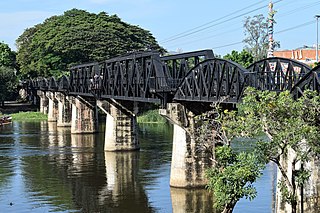
The Burma Railway, also known as the Siam–Burma Railway, Thai–Burma Railway and similar names, or as the Death Railway, is a 415 km (258 mi) railway between Ban Pong, Thailand, and Thanbyuzayat, Burma. It was built from 1940 to 1943 by South East Asian civilians abducted and forced to work by the Japanese and a smaller group of captured Allied soldiers, to supply troops and weapons in the Burma campaign of World War II. It completed the rail link between Bangkok, Thailand, and Rangoon, Burma. The name used by the Japanese Government was Tai–Men Rensetsu Tetsudō (泰緬連接鉄道), which means Thailand-Burma-Link-Railway.

The Kempeitai was the military police of the Imperial Japanese Army. The organization also shared civilian secret police, espionage, and counter-intelligence roles within Japan and its occupied territories, and was notorious for its brutality and role in suppressing dissent. The broad duties of the Kempeitai included maintaining military discipline, enforcing conscription laws, protecting vital military zones, and investigating crimes among soldiers. In occupied areas, it also issued travel permits, recruited labor, arrested resistance, requisitioned food and supplies, spread propaganda, and suppressed anti-Japanese sentiment. At its peak at the end of World War II, the Kempeitai was an extensive corps with about 35,000 personnel.
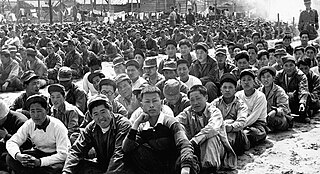
A prisoner-of-war camp is a site for the containment of enemy fighters captured as prisoners of war by a belligerent power in time of war.
Marlag und Milag Nord was a Second World War German prisoner-of-war camp complex for men of the British and Canadian Merchant Navy and Royal Navy. It was located around the village of Westertimke, about 30 km (19 mi) north-east of Bremen, though in some sources the camp's location is given as Tarmstedt, a larger village about 4 km (2.5 mi) to the west. There were also American merchant seamen detained here as well as some U.S. Navy personnel.

A hell ship is a ship with extremely inhumane living conditions or with a reputation for cruelty among the crew. It now generally refers to the ships used by the Imperial Japanese Navy and Imperial Japanese Army to transport Allied prisoners of war (POWs) and rōmusha out of the Philippines, the Dutch East Indies, Hong Kong and Singapore in World War II. These POWs were taken to the Japanese Islands, Formosa, Manchukuo, Korea, the Moluccas, Sumatra, Burma, or Siam to be used as forced labor.

Camp O'Donnell is a current military base and former United States military reservation in the Philippines located on Luzon island in the municipality of Capas in Tarlac. It housed the Philippine Army's newly created 71st Division and after the Americans' return, a United States Army camp. During World War II, the reservation was used as a prisoner-of-war camp for Filipino and American soldiers captured by Japan during its successful invasion of the Philippines. About 60,000 Filipino and 9,000 Americans were housed at the camp. During the few months in 1942 that Camp O'Donnell was used as a prisoner-of-war camp, about 20,000 Filipinos and 1,500 Americans died there of disease, starvation, neglect, and brutality.

Featherston prisoner of war camp was a camp for captured Japanese soldiers during World War II at Featherston, New Zealand, notorious for a 1943 incident in which 48 Japanese and one New Zealander were killed. The camp had been established during World War I as a military training camp and had also been used as an internment camp from 1918 to 1920, when 14 German internees remained there.
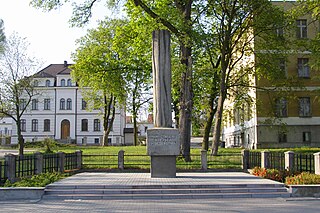
Oflag 64 was a World War II German prisoner-of-war camp for officers located at Szubin a few miles south of Bydgoszcz, in Pomorze, Poland, which at that time was occupied by Nazi Germany. It was probably the only German POW camp set up exclusively for U.S. Army ground component officers. At most other camps there were several nationalities, although they were usually separated into national compounds.

Batu Lintang camp at Kuching, Sarawak on the island of Borneo was a Japanese-run internment camp during the Second World War. It was unusual in that it housed both Allied prisoners of war (POWs) and civilian internees. The camp, which operated from March 1942 until the liberation of the camp in September 1945, was housed in buildings that were originally British Indian Army barracks. The original area was extended by the Japanese, until it covered about 50 acres. The camp population fluctuated, due to movement of prisoners between camps in Borneo, and as a result of the deaths of the prisoners. It had a maximum population of some 3,000 prisoners.

The Selarang Barracks incident, also known as the Barrack Square incident or the Selarang Square Squeeze, was a revolt of British and Australian prisoners-of-war (POWs) interned in a Japanese camp in Changi, Singapore.

Lionel Colin Matthews, was an Australian Army officer in World War II. He was posthumously awarded the George Cross, the highest award for extraordinary acts of gallantry away from the field of battle that could be awarded to a member of the Australian armed forces at the time. Matthews was born in Adelaide, South Australia, and was schooled there before moving to Victoria. He trained as a signalman in the Royal Australian Naval Reserve before joining the Militia in April 1939. Commissioned as an officer in the Australian Corps of Signals, Matthews transferred to the 8th Division of the Second Australian Imperial Force after the outbreak of World War II.
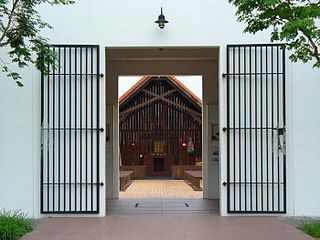
The Changi Chapel and Museum is a war museum dedicated to Singapore's history during the Second World War and the Japanese occupation of Singapore. After the British Army was defeated by the Imperial Japanese Army in the Battle of Singapore, thousands of prisoners of war (POWs) were imprisoned in Changi prison camp for three and a half years. While interned there, the POWs built numerous chapels, one of which was named St George's Church.
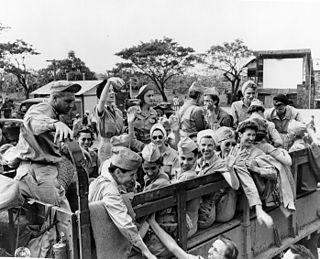
The Angels of Bataan were the members of the United States Army Nurse Corps and the United States Navy Nurse Corps who were stationed in the Philippines at the outset of the Pacific War and served during the Battle of the Philippines (1941–1942). When Bataan and Corregidor fell, 11 navy nurses, 66 army nurses, and 1 nurse-anesthetist were captured and imprisoned in and around Manila. They continued to serve as a nursing unit while prisoners of war. After years of hardship, they were finally liberated in February 1945.

During World War II, it was estimated that between 35,000 and 50,000 members of the Imperial Japanese Armed Forces surrendered to Allied servicemembers prior to the end of World War II in Asia in August 1945. Also, Soviet troops seized and imprisoned more than half a million Japanese troops and civilians in China and other places. The number of Japanese soldiers, sailors, marines, and airmen who surrendered was limited by the Japanese military indoctrinating its personnel to fight to the death, Allied combat personnel often being unwilling to take prisoners, and many Japanese soldiers believing that those who surrendered would be killed by their captors.

The Palawan massacre occurred on 14 December 1944, during World War II, near the city of Puerto Princesa in the Philippine province of Palawan. Allied soldiers, imprisoned near the city, were killed by Imperial Japanese soldiers. Only eleven men managed to survive.
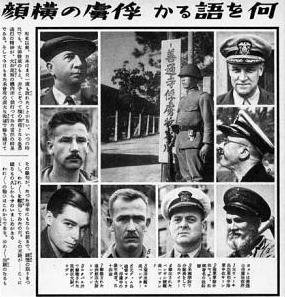
The Ōfuna Camp was an Imperial Japanese Navy installation located in Kamakura, outside Yokohama, Japan during World War II, where high-value enlisted and officers, particularly pilots and submariner prisoners of war were incarcerated and interrogated by Japanese naval intelligence. Richard O'Kane, Louis Zamperini and Gregory Boyington were among the prisoners held at Ōfuna.

The Thanbyuzayat War Cemetery is a prisoner of war cemetery for victims of Japanese imprisonment who died building the Death Railway in Burma. It is at the Burmese end of the Second World War railway construction, in Thanbyuzayat, 65 kilometres south of Mawlamyine (Moulmein). Thanbyuzayat is considered the terminus of the Death Railway, and is where it connected with the Burmese main line.

Felix James McCool was a United States Marine Corps chief warrant officer 3. He is one of two Marines to be captured as a prisoner of war (POW) twice, the first during World War II, and the second during the Korean War. Spending more than six years total in captivity, McCool held the record as the longest-held Marine POW until surpassed by several other Marines during the Vietnam War.



















